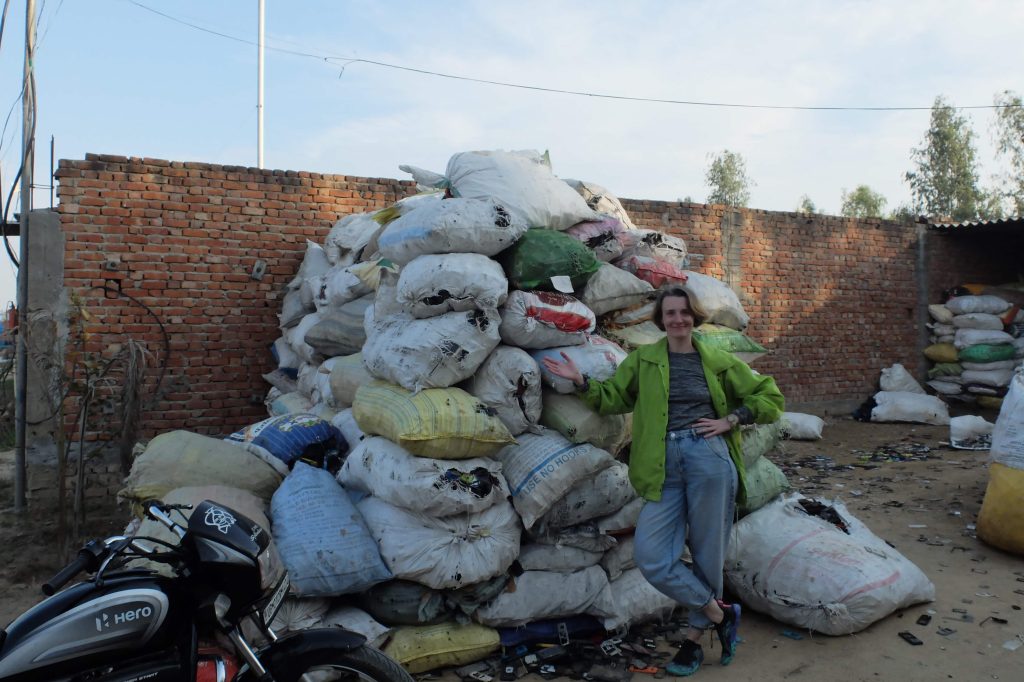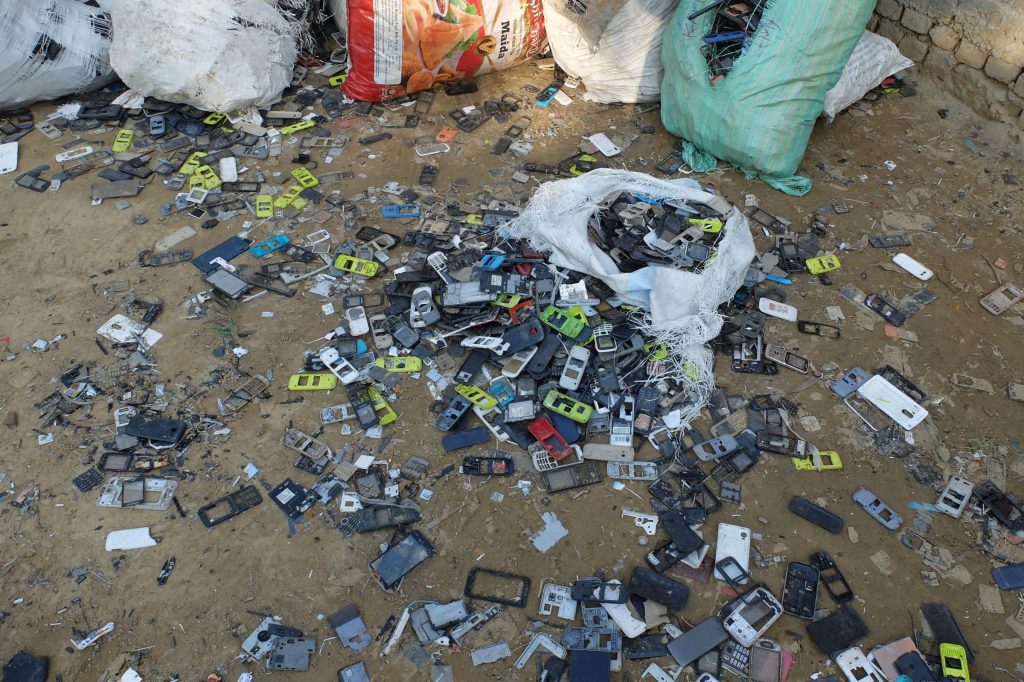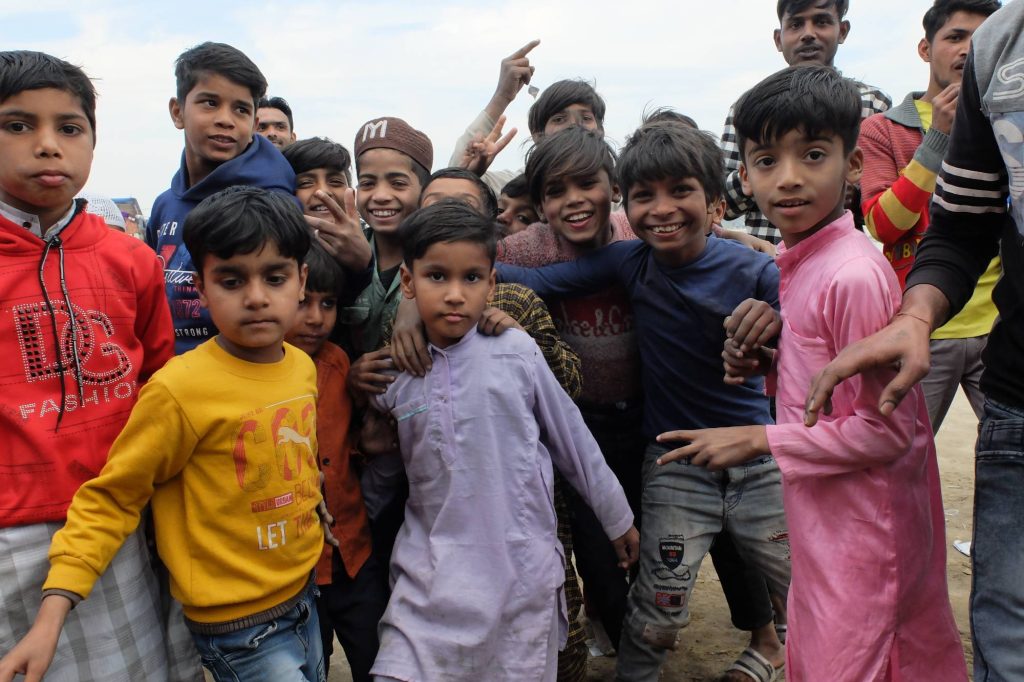Joanna Murzyn is on a mission to redefine our relationship with technology. As a propagator of Digital Ecology, she challenges the unchecked growth of digital consumption and its hidden environmental costs. A hacker at heart and a consultant in sustainable digitization, she has spent over a decade designing regenerative digital solutions that prioritize both human well-being and planetary health. From advocating for free and open-source software to tackling the mounting crisis of e-waste, Joanna believes that the future of tech must serve people, not just profit.
Murzyn’s journey from UX designer to systemic designer is a profound transformation sparked by a visit to an e-waste dumpsite in India. “I’ll never forget the look of misery in [the little boy’s] eyes,” she recalls, describing children dismantling keyboards amidst towering stacks of discarded technology. This jarring experience ignited a passion for understanding the complete lifecycle of devices and their impact on vulnerable communities, leading her to champion a life-centered design approach where technology serves both human needs and planetary health.
My first visit to an e-waste dumpsite in India five years ago left a profound mark on me. I remember the most one very small family-run workshop. Inside, there was a little boy taking keyboards apart. I’ll never forget the look of misery in his eyes
In a world of rapid technological advancement, where upgrades are constant, Murzyn challenges us to consider the true costs of our digital desires. Inspired by practices like Vipassana meditation, which has brought “a sense of calmness to my design and business approaches,” she advocates for sustainable UX design and responsible technology consumption. Murzyn extends the life of her own nine-year-old smartphone, promoting open-source solutions, and highlighting the need to question increasing app sizes and data usage. This commitment underscores her belief in a more conscious and equitable digital future.
Currently in India, she is working on community-driven solutions to address the global e-waste crisis, blending her expertise in regenerative IT with Buddhist teachings and meditation practices. For Joanna, hacking isn’t just about breaking code—it’s about dismantling unsustainable systems and rebuilding them for a more responsible digital future.

More than just a designer, Murzyn is a visionary, urging us to embrace an interconnectedness with all life. Challenging the industry’s pursuit of “newer and smaller,” she asks, “What are the consequences of this, and what happens to the devices and communities we leave behind?” Her life-centered design prioritizes all stakeholders – “users, non-users, local communities, and ecosystems.” By expanding our focus beyond immediate human needs, Murzyn seeks to create designs that respect and support the intricate web of life.
Murzyn is not a typical tech expert. With a foundation in mindfulness and data minimalism, she advocates for “consciousness alongside technological advancement.” Acknowledging that “technological growth cannot be separated from personal development,” she calls for emotional intelligence and an ethical framework to guide innovation. Murzyn champions the potential of emerging technologies like blockchain and AI for good while emphasizing the importance of rethinking who the primary stakeholders are to ensure tech benefits “our environment and civilization.”
We caught up with Joanna to talk about all things digital ecology—here’s our conversation.
- Reflecting on your transformative experience at the e-waste dumpsite in India, how did that moment reshape your understanding of technology’s impact on our environment? How can designers incorporate this understanding of the lifecycle and environmental impact of devices into their UX processes?
- You’ve mentioned that you exclusively use open-source solutions and prolong the life cycle of your devices—like your smartphone, which is over nine years old! How is this achievable at a large scale in a market where profit-driven companies encourage frequent upgrades?
- In some of your writings, you have mentioned the intergenerational trauma faced by children in toxic environments due to e-waste processing. How can designers and educators collaborate to raise awareness about these issues?
- You often call for a deeper understanding of our interconnectedness with all life forms. In your opinion, how can this philosophy be integrated into the principles of sustainable UX design?
- As someone who incorporates personal practices like meditation and consciousness exploration into your work, how do these practices influence your approach to technology and sustainability?
- What role do you see for emerging technologies, such as AI and blockchain, in addressing issues related to e-waste?
Reflecting on your transformative experience at the e-waste dumpsite in India, how did that moment reshape your understanding of technology’s impact on our environment? How can designers incorporate this understanding of the lifecycle and environmental impact of devices into their UX processes?
Joanna: My first visit to an e-waste dumpsite in India five years ago left a profound mark on me. I remember the most one very small family-run workshop. Inside, there was a little boy taking keyboards apart. I’ll never forget the look of misery in his eyes. When I asked his father’s permission to enter, I discovered more children inside, all doing the same work with keyboards. What truly shocked me were the amount: thousands of keyboards surrounding them, stacked from floor to ceiling.
Those discarded keyboards became a powerful symbol for me – representing the transformation from personal computers to touchscreen solutions. They stood as physical evidence of how quickly we discard ‘obsolete’ technology in our rush toward newer interfaces.
I used to be a UX designer myself, but that role felt too narrow for addressing the complex challenges we face. I’ve expanded my approach to become a systemic designer, which allows me to look at anything I design from a broader perspective. This shift wasn’t just about changing my title – it reflected my growing understanding that design decisions have ripple effects far beyond the user interface. It’s about seeing the interconnections between user experience, environmental impact, and social responsibility.
And that is why I believe what is important for us – designers, is consciousness of the long-term decisions we make and understanding of the ecosystems they operate in.

Let’s take our electronic devices as an example. Their lifecycle is directly tied to software design decisions and operating system support. Often, we’re forced to replace perfectly functional phones simply because newer applications no longer support older operating systems. This creates an artificial obsolescence – our devices still work, but we’re pushed to upgrade them due to software limitations rather than hardware failures.
There is a massive need to embrace a more systematic approach and take greater responsibility by pressuring to maintain accessibility for older devices.
The image of that workshop filled with discarded keyboards has made me deeply question our industry’s obsession with minimalism and optimization, particularly the trend toward mobile-only solutions. While mobile applications can be more environmentally efficient due to their smaller footprint and lower energy consumption, as designers we also should confront a crucial question: what are the consequences of this pursuit of ‘newer and smaller,’ and what happens to the devices and communities we leave behind in this process?
You’ve mentioned that you exclusively use open-source solutions and prolong the life cycle of your devices—like your smartphone, which is over nine years old! How is this achievable at a large scale in a market where profit-driven companies encourage frequent upgrades?
Joanna: After experiencing the direct and indirect consequences of our technological pursuit in e-waste dumpsters, I decided to take a step back and rethink my role in this system.
I began by stepping away from social media, realizing that their design patterns are partly a root cause of the issue. Digging deeper, I discovered how crucial openness is for energy and code efficiency.
Let’s take our mobile apps as an example, their average size have increased by over 1000% in only last 4 year, yet as consumers, our only options are to buy phones with more storage or purchase extra cloud space – we rarely understand what’s driving this growth. Potentially those are extremely sophisticated AI based solutions and tracking technologies causing need for more processing power and energy consumption.
Research clearly shows that the primary factor affecting our phones’ lifecycle is daily usage time. We can start using them responsibly and consciously, avoiding the trap of infinite scrolls
Research clearly shows that the primary factor affecting our phones’ lifecycle is daily usage time. This doesn’t mean we need to completely abandon our devices – that would be impractical.
Instead, we can start using them responsibly and consciously, avoiding the trap of infinite scrolls and distracting banners.
This is also a call to designers to create efficient and genuinely useful products that allow users to accomplish their tasks in less time, ultimately reducing device usage and extending hardware life.
From a market perspective, for years success has been measured by the volume of products sold. However, this leaves behind those who cannot or choose not to keep up with the relentless pace of technological development.
But recently, especially in Europe, I’m seeing a trend of companies that aren’t solely profit-driven, but instead prioritize environmental responsibility and consider their broader impact. I believe this kind of reflection and redefinition will continue to grow.
In some of your writings, you have mentioned the intergenerational trauma faced by children in toxic environments due to e-waste processing. How can designers and educators collaborate to raise awareness about these issues?
Let me first clarify what I mean by intergenerational trauma.
In low-income communities facing traumatic conditions, people often lack the time, energy, and support needed to escape their circumstances. This is typically caused by a lack of resources, systemic support, or access to knowledge.
New generations growing up in these conditions can barely imagine a different future for themselves. They absorb what they see and accept this reality as their only option, likely following the same path because they see no alternatives.
Whether we are designers, educators, or simply human beings, we must acknowledge this reality and help others break free from cycles of poverty and challenging life situations in which they find themselves trapped.

I believe it’s crucial to react and not remain silent in the face of systemic violence, which is how I view the current state of e-waste management. Countries from the global minority use their position of power to exploit people who have no choice.
To understand this dynamic, we need to recognize an important paradox: a small number of economically powerful countries (the global minority) hold disproportionate influence over a much larger number of resource-rich but economically disadvantaged nations (the global majority). This creates a system where the minority’s consumption patterns and economic decisions often lead to the exploitation of labor and resources in majority countries, perpetuating cycles of poverty and environmental degradation.
This is a cycle of trauma that must be broken.
When those trapped within the system lack the energy and resources to break free, it’s essential that we provide support from the outside. As privileged members of society who don’t have to fight for survival, we need to stay aware and ask critical questions of companies – especially those involved in recycling practices: Where are their facilities? Who are they hiring? Do these workers have proper contracts?
This isn’t just about corporate responsibility, it’s about our collective duty to care not only for ourselves but also for those caught in these exploitative systems.
You often call for a deeper understanding of our interconnectedness with all life forms. In your opinion, how can this philosophy be integrated into the principles of sustainable UX design?
I believe that adopting a life-centered design approach is an essential starting point for sustainable UX design. This approach emphasizes the interconnectedness of all life forms and aims to create solutions that benefit not just humans, but entire ecosystems and communities.
Life-centered design advocates for a holistic perspective that considers all stakeholders – users, non-users, local communities, and ecosystems – rather than focusing purely on end-users and business interests.
A simple decision about data storage or processing location can affect energy consumption, which in turn impacts local environments and communities.
By expanding our view beyond only human needs, we can better understand how our design decisions impact the planet and its inhabitants.
A core principle of life-centered design is developing empathy with nature, which goes far beyond just reducing environmental impact. It means understanding that our digital products exist within living ecosystems – from the minerals in our devices to the energy powering our servers. When we design, we need to consider how our choices ripple through these natural systems.
For example, a simple decision about data storage or processing location can affect energy consumption, which in turn impacts local environments and communities.
Transparency and education are crucial in implementing this approach. This includes being transparent with users about data usage and storage practices.
We might even need to rethink traditional business models – instead of offering “free” products in exchange for user data, we could explore models where users can tokenize their data and receive direct economic benefits from its use, creating a more equitable and transparent digital ecosystem.
As someone who incorporates personal practices like meditation and consciousness exploration into your work, how do these practices influence your approach to technology and sustainability?
I believe that the quality of our minds and souls is reflected in what we create and bring into reality. Through my meditation practice, I’ve noticed how it has brought a sense of calmness to my design and business approaches.
This mindfulness has led me to embrace data minimalism – I’m no longer overproducing content. Instead, I focus on deep reflection to determine exactly what I want to communicate and build, allowing me to be more direct and purposeful.

In terms of sustainability, I can proudly say that I’ve evolved even beyond this concept and adopt a regenerative approach. While sustainability is about the “ability to sustain”, being regenerative means recognizing that “I have enough” and can now direct my imagination, time, and efforts toward helping others also reach this stage.
I can proudly admit that my relationship with technology has become healthier. I consciously choose high-quality content that I know will benefit me, moving away from mindless social media scrolling.
One of the most significant changes was switching my phone display to black and white.
This simple shift has increased my ability to focus deeply and improved my reading habits. I spend less time on my device, but more importantly, I’ve started to notice and appreciate the colors in the world around me rather than having my brain constantly stimulated by bright screens and flashy banners.
This change has given me more confidence and significantly increased my sense of inner peace and happiness.
What I’ve found most remarkable about this journey is how transformative it has been.
By changing myself, I naturally redefined my environment, which in turn began to enrich my life in unexpected ways. This circular process of personal growth leading to environmental change, which then feeds back into personal development, has been and still is, an extremely powerful process.
And btw, for those who would like to know, I practice Vipassana 🙂
What role do you see for emerging technologies, such as AI and blockchain, in addressing issues related to e-waste?
To be honest, I’m very optimistic and excited about emerging technologies, as I see them as tools for societal transformation. The crucial question, however, is who controls these technologies and what values they hold.
I see huge potential in blockchain technology for increasing supply chain transparency to prevent exploitation and ensure cruelty-free workplaces as a mandatory aspect of technology development.
Artificial Intelligence can play a crucial role in better understanding and optimizing resource management.
Whose needs are driving these technologies? Are they serving venture capitalists who make technologies profit-driven, or are they serving our environment and civilization, which could reach a higher state of development with these tools?
The opportunities are endless – it’s a matter of how we choose to use these technologies. Of course, these solutions come with inherent risks. However, I believe that as more people openly discuss them, they will become an integral part of the development process. This awareness might lead to better decision-making at the earliest stages of implementation, where we can properly evaluate whether certain solutions are worth pursuing.
I think the main challenge we should face is rethinking who our primary stakeholders are. Whose needs are driving these technologies? Are they serving venture capitalists who make technologies profit-driven, or are they serving our environment and civilization, which could reach a higher state of development with these tools?
Another crucial dimension that demands our reflection is the need to develop our consciousness alongside technological advancement. Technological growth cannot be separated from personal development – they must progress in parallel. As these tools become more powerful, we need to develop the wisdom and awareness to be responsible stewards of such transformative technologies.
This means cultivating not just technical expertise, but also the emotional intelligence and ethical framework needed to guide these innovations toward the benefit of all life on our planet.









